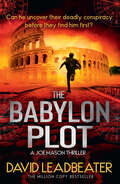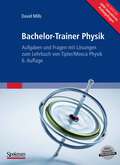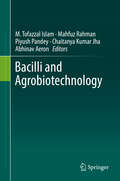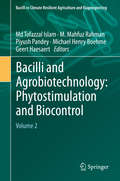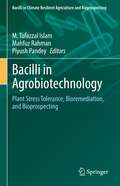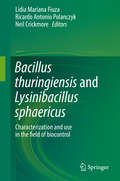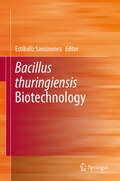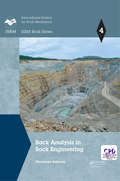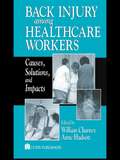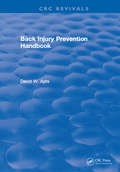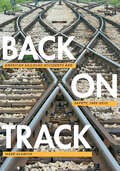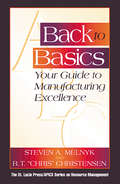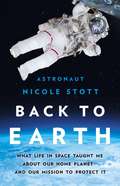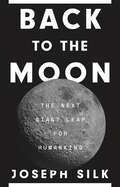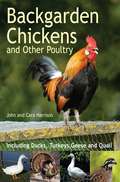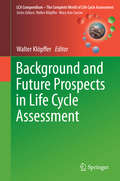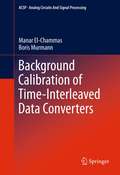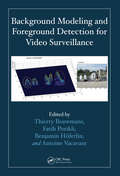- Table View
- List View
The Babylon Plot (Joe Mason #4)
by David Leadbeater‘Five-star turbo-charged, non-stop action thriller… It reads like a movie reel… Needs to be on every thrill seeker’s reading list’ NetGalley review ⭐⭐⭐⭐⭐ Don’t miss the next instalment of the Joe Mason series, from million-copy bestselling author David Leadbeater.
Bachelor-Trainer Physik: Aufgaben und Fragen mit Lösungen zum Lehrbuch von Tipler/Mosca Physik 6. Auflage inclusive interaktive DVD zum Selbsttest
by David MillsDer Bachelor-Trainer zum Physiklehrbuch von Paul A. Tipler und Gene Mosca enthält die ausführlichen Lösungen zu allen in der sechsten deutschen Lehrbuchausgabe gestellten Aufgaben, und zwar in derselben Gliederung nach den Bereichen Mechanik, Schwingungen und Wellen, Thermodynamik, Elektrizität und Magnetismus, Licht und schließlich Moderne Physik (Quantentheorie, Relativitätstheorie und Struktur der Materie). Für Studenten bietet diese in sich geschlossene Aufgabensammlung mit Lösungen vielfältige Anregungen, um praxisnah und mit Blick auf Standardexperimente physikalisches Problemlösen mit Hilfe von ganz elementarem mathematischen Handwerkszeug zu entdecken, auszuprobieren und einzuüben - und zwar mit Spaß und Erfolgsgarantie! Denn die Lösungen werden schrittweise dargelegt.
Bacilli and Agrobiotechnology (Bacilli in Climate Resilient Agriculture and Bioprospecting)
by M. Tofazzal Islam Mahfuz Rahman Piyush Pandey Chaitanya Kumar Jha Abhinav AeronThis volume of comprehensive reviews updates our knowledge of research and commercialization of Bacillus-based products in agriculture and the environmental sector. The last couple of decades have witnessed tremendous growth of research on Bacillus species. Many of these species can produce industrial enzymes, and can act simultaneously as biofertilizers and as biopesticides inhibiting important phytopathogens. This "biocontrol" activity is now elucidated by a number of genomic and metabolomic studies. Bacillus formulations are being patented and commercialized on a regular basis. Understanding the biology, ecology and mechanism of action of these bacteria will play a role in the promotion of Bacillus-based products to support green technology in agriculture and agro-based industries.
Bacilli and Agrobiotechnology: Volume 2 (Bacilli in Climate Resilient Agriculture and Bioprospecting)
by Md Tofazzal Islam M. Mahfuz Rahman Piyush Pandey Michael Henry Boehme Geert HaesaertThe Gram-positive and spore-forming Bacilli are the most dominant group of bacteria that exist in various ecological niches on the earth. They represent one of the most important unmapped pools of biodiversity with immense potential of applications in agriculture, environment, and industry. As these bacteria are highly tolerant to stressful environment and enhance plant tolerance to harsh environment such as salinity, drought, and heavy metal toxicity, plant-associated Bacilli have high potential for promoting sustainable crop production. Many species of Bacilli are being commercially used as phytostimulator and biofertilizer. Some of them are applied as biopesticide for protecting crop plants from phytopathogens and insect pests. The Bacillus-based products are becoming popular in ecologically sound and climate resilient agricultural production system. In fact, Bacillus and allied species based formulations are already dominating the biopesticides market, although, to compete with other formulations and chemical alternatives, the biology of Bacillus had to be understood from perspective of such applications. Our understanding of the biology and molecular-basis of the beneficial effects of plant-associated Bacilli has greatly been progressed in recent years through genomics, metagenomics, post-genomics and metabolomics studies. The volume two of the series Bacilli and Agrobiotechnology comprehensively reviews and updates current knowledge of Bacilli as phytostimulant and biological control of plant pests. Better understanding the biology, ecology and mechanism of action of the beneficial strains of Bacilli will play a role in the development of products to support green biotechnology in agriculture and industries.
Bacilli in Agrobiotechnology: Plant Stress Tolerance, Bioremediation, and Bioprospecting (Bacilli in Climate Resilient Agriculture and Bioprospecting)
by M. Tofazzal Islam Mahfuz Rahman Piyush PandeyThe third volume of the series ‘Bacilli and Agrobiotechnology’ is comprised of 25 chapters that bring a unique perspective to the readers about Bacillus-mediated biotic and abiotic plant stress tolerance, bioremediation and bioprospecting. These chapters are prepared by the leading scientists of global repute. The negative impacts of agrochemicals such as chemical fertilizers and pesticides on human health and environment are paramount. Bacillus and allied genera of beneficial plant-associated microbes are presenting beacon of hope to the farmers, plant scientists and stewards of environment. Several chapters of this volume focus on the induction of various signaling pathways in plants by Bacillus spp. to alleviate biotic and abiotic stresses impacted by global climate change Agricultural lands contaminated with heavy metals affect the ecological food chain starting from crop cultivation. How the toxic effects of trace metals originating from industrial effluents and agrochemicals can be remediated? This book addresses how to overcome these issues by applying elite strains of Bacillus. Bioprospecting is a systematic and organized search for conversion of bioresources to industrially important products by utilizing microbe-derived metabolites. This volume is enriched by including the bioprospecting aspects mediated by Bacillus spp. with novel insights.
Bacillus thuringiensis: A Cornerstone of Modern Agriculture
by Matthew MetzMake the right decisions when it comes to pest control in agriculture!Bacillus thuringiensis: A Cornerstone of Modern Agriculture explores the impact that one of the most prominent biologically based pesticides has had on pest control technologyand the issues that surround its use. The book examines the development, use, and management of technologies derived from Bacillus thuringiensis (Bt), addressing the health, economic, environmental, and social concerns generated by the deployment of genetically engineered crops. Authors representing a diverse cross section of the international scientific community contribute review articles and research findings that address the use of Bt in microbial formulations and transgenic crops, technological advances in the genetic engineering of plants, advances in methodologies, and improved agricultural practices and productivity through the use of Bt cotton.Bacillus thuringiensis: A Cornerstone of Modern Agriculture examines the vital issues surrounding this Gram-positive bacterium. Contributors from academia, government, and industry address the safety of Bt for human consumption, its effects on non-target organisms, the role of microbial Bt products in crop production in the United States, and the utility and management of transgenic plants. The book also explores: engineering Bt transgenic rice for insect pest protection the Bt potato in developing countries Bt expression in sugarcane and cauliflower a comparative analysis of Bt cotton in Argentina the ecological impact, gene expression, and current resistance management requirements of Bt cotton in the United States and much more! Bacillus thuringiensis: A Cornerstone of Modern Agriculture is an essential resource for advanced students and technical specialists working in agriculture, biotechnology, entomology, pest management, and crop sciences. Stakeholders will also find it invaluable in regulatory decision making about genetically engineered crops, pesticide use, and crop protection.
Bacillus thuringiensis: A Cornerstone of Modern Agriculture
by Matthew MetzMake the right decisions when it comes to pest control in agriculture!Bacillus thuringiensis: A Cornerstone of Modern Agriculture explores the impact that one of the most prominent biologically based pesticides has had on pest control technologyand the issues that surround its use. The book examines the development, use, and management of technologies derived from Bacillus thuringiensis (Bt), addressing the health, economic, environmental, and social concerns generated by the deployment of genetically engineered crops. Authors representing a diverse cross section of the international scientific community contribute review articles and research findings that address the use of Bt in microbial formulations and transgenic crops, technological advances in the genetic engineering of plants, advances in methodologies, and improved agricultural practices and productivity through the use of Bt cotton.Bacillus thuringiensis: A Cornerstone of Modern Agriculture examines the vital issues surrounding this Gram-positive bacterium. Contributors from academia, government, and industry address the safety of Bt for human consumption, its effects on non-target organisms, the role of microbial Bt products in crop production in the United States, and the utility and management of transgenic plants. The book also explores: engineering Bt transgenic rice for insect pest protection the Bt potato in developing countries Bt expression in sugarcane and cauliflower a comparative analysis of Bt cotton in Argentina the ecological impact, gene expression, and current resistance management requirements of Bt cotton in the United States and much more! Bacillus thuringiensis: A Cornerstone of Modern Agriculture is an essential resource for advanced students and technical specialists working in agriculture, biotechnology, entomology, pest management, and crop sciences. Stakeholders will also find it invaluable in regulatory decision making about genetically engineered crops, pesticide use, and crop protection.
Bacillus thuringiensis and Lysinibacillus sphaericus: Characterization and use in the field of biocontrol
by Lidia Mariana Fiuza Ricardo Antonio Polanczyk Neil CrickmoreThis volume presents a comprehensive perspective of the biopesticides Bacillus thuringiensis and Lysinibacillus sphaericus, from their basic biology to agriculture, forestry and public-health applications. It covers their ecology, virulence factors, and genetic characterization. The topics related to agriculture and forestry include mode of action, receptors of insect pests, and heterologous expression of toxins in insect cells and plants. Public-health researchers will find information on vector control programs with an emphasis on the Neotropical region. The book also discusses new products and the global market.
Bacillus thuringiensis Biotechnology
by Estibaliz SansineneaBacillus thuringiensis (Bt) has been used as a biopesticide in agriculture, forestry and mosquito control because of its advantages of specific toxicity against target insects, lack of polluting residues and safety to non-target organisms. The insecticidal properties of this bacterium are due to insecticidal proteins produced during sporulation. Despite these ecological benefits, the use of Bt biopesticides has lagged behind the synthetic chemicals. Genetic improvement of Bt natural strains, in particular Bt recombination, offers a promising means of improving efficacy and cost-effectiveness of Bt-based bioinsecticide products to develop new biotechnological applications. On the other hand, the different Bacillus species have important biotechnological applications; one of them is carried out by producing secondary metabolites, which are the study object of natural product chemistry. The amazing structural variability of these compounds has attracted the curiosity of chemists and the biological activities possessed by natural products have inspired the pharmaceutical industry to search for lead structures in microbial extracts. Screening of microbial extracts reveals the large structural diversity of natural compounds with broad biological activities, such as antimicrobial, antiviral, immunosuppressive, and antitumor activities that enable the bacterium to survive in its natural environment. These findings widen the target range of Bacillus spp., in special B. thuringiensis, besides insecticidal activity and help people to better understand its role in soil ecosystem.
Back Analysis in Rock Engineering (ISRM Book Series)
by Shunsuke SakuraiThis book provides practicing engineers working in the field of design, construction and monitoring of rock structures such as tunnels and slopes with technical information on how to design, how to excavate and how to monitor the structures during their construction. Based on the long-term engineering experiences of the author, field measurements together with back analyses are presented as the most powerful tools in rock engineering practice. One of the purposes of field measurements is to assess the stability of the rock structures during their construction. However, field measurement results are only numbers unless they are quantitatively interpreted, a process in which back analyses play an important role. The author has developed both the concepts of “critical strain” and of the “anisotropic parameter” of rocks, which can make it possible not only to assess the stability of the structures during their construction, but also to verify the validity of design parameters by the back analysis of field measurement results during the constructions. Based on the back analysis results, the design parameters used at a design stage could be modified if necessary. This procedure is called an “Observational method”, a concept that is entirely different from that of other structures such as bridges and buildings. It is noted that in general, technical books written for practicing engineers mainly focus on empirical approaches which are based on engineers’ experiences. In this book, however, no empirical approaches will be described, instead, all the approaches are based on simple rock mechanics theory. This book is the first to describe an observational method in rock engineering practice, which implies that the potential readers of this book must be practicing engineers working on rock engineering projects.
Back Analysis in Rock Engineering (ISRM Book Series)
by Shunsuke SakuraiThis book provides practicing engineers working in the field of design, construction and monitoring of rock structures such as tunnels and slopes with technical information on how to design, how to excavate and how to monitor the structures during their construction. Based on the long-term engineering experiences of the author, field measurements together with back analyses are presented as the most powerful tools in rock engineering practice. One of the purposes of field measurements is to assess the stability of the rock structures during their construction. However, field measurement results are only numbers unless they are quantitatively interpreted, a process in which back analyses play an important role. The author has developed both the concepts of “critical strain” and of the “anisotropic parameter” of rocks, which can make it possible not only to assess the stability of the structures during their construction, but also to verify the validity of design parameters by the back analysis of field measurement results during the constructions. Based on the back analysis results, the design parameters used at a design stage could be modified if necessary. This procedure is called an “Observational method”, a concept that is entirely different from that of other structures such as bridges and buildings. It is noted that in general, technical books written for practicing engineers mainly focus on empirical approaches which are based on engineers’ experiences. In this book, however, no empirical approaches will be described, instead, all the approaches are based on simple rock mechanics theory. This book is the first to describe an observational method in rock engineering practice, which implies that the potential readers of this book must be practicing engineers working on rock engineering projects.
Back Injury Among Healthcare Workers: Causes, Solutions, and Impacts
by William Charney Anne HudsonThe U.S. Bureau of Labor Statistics recently calculated nearly 60,000 musculoskeletal injuries to healthcare workers resulting from heavy lifting during attempts to move patients. Often the nurses, aides, orderlies, and attendants who suffered permanent injuries were forced out of the profession, straining an already inadequate pool of workers and
Back Injury Among Healthcare Workers: Causes, Solutions, and Impacts
by William Charney Anne HudsonThe U.S. Bureau of Labor Statistics recently calculated nearly 60,000 musculoskeletal injuries to healthcare workers resulting from heavy lifting during attempts to move patients. Often the nurses, aides, orderlies, and attendants who suffered permanent injuries were forced out of the profession, straining an already inadequate pool of workers and
Back Injury Prevention Handbook
by David W. AptsBack injuries can be controlled and prevented! They are not and should not be accepted as a cost of doing business!Written in plain language for the industrial professional, this book presents back injury prevention methods that have proven effective for cost containment. Such techniques include the 5-year back attack, the Olympic weight lifting model applied to the industrial setting. Training styles, and concepts for a proper educational format are also emphasized.The author draws on literature from around the world and his own experience of over 20 years of treating and preventing back pain and neck pain in presenting information in this book. Several case studies prove that back injuries can be prevented, which can save hundreds of thousands of dollars and countless hours of lost work. This book will prove essential for helping trainers, safety specialists, ergonomists, industrial hygienists, and other industry personnel to implement the best cure for back pain-prevention!
Back Injury Prevention Handbook
by David W. AptsBack injuries can be controlled and prevented! They are not and should not be accepted as a cost of doing business!Written in plain language for the industrial professional, this book presents back injury prevention methods that have proven effective for cost containment. Such techniques include the 5-year back attack, the Olympic weight lifting model applied to the industrial setting. Training styles, and concepts for a proper educational format are also emphasized.The author draws on literature from around the world and his own experience of over 20 years of treating and preventing back pain and neck pain in presenting information in this book. Several case studies prove that back injuries can be prevented, which can save hundreds of thousands of dollars and countless hours of lost work. This book will prove essential for helping trainers, safety specialists, ergonomists, industrial hygienists, and other industry personnel to implement the best cure for back pain-prevention!
Back on Track: American Railroad Accidents and Safety, 1965;€“2015 (Hagley Library Studies in Business, Technology, and Politics)
by Mark AldrichThroughout the early twentieth century, railroad safety steadily improved across the United States. But by the 1960s, American railroads had fallen apart, the result of a regulatory straightjacket that eroded profitability and undermined safety. Collisions, derailments, worker fatalities, and grade crossing mishaps skyrocketed, while hazmat disasters exploded into newspaper headlines. In Back on Track, his sequel to Death Rode the Rails, Mark Aldrich traces the history of railroad accidents beginning in 1965, when Congress responded to bankrupt and scandal-ridden carriers by enacting a new safety regime. Aldrich details the federalization of rail safety and the implementation of a massive grade crossing program. He touches on post-1976 economic deregulation, which provided critical financing that underwrote better public safety. He also explores how the National Transportation Safety Board acted as a public scold to shine bright lights on private failings, while Federal Railroad Administration regulations reinforced market incentives for better safety. Ultimately, Aldrich concludes, the past 50 years have seen great strides in restoring railroad safety while enhancing industry profitability. Arguing that it was not inadequate safety regulation but rather stifling economic regulation that initially caused an uptick in train accidents, Back on Track is both a paen to the return of more competitive railroading and the only comprehensive history of the safety of modern American railroads. Praise for Death Rode the Rails"A masterful study of the complex evolution of railroad safety.";¢;‚¬;€?American Historical Review"Students of rail safety, and today's Class I railroad managers, need to read this volume.";¢;‚¬;€?Trains"Aldrich has created a masterpiece. His research is extensive, drawing on a rich variety of obscure yet relevant sources.";¢;‚¬;€?Register of the Kentucky Historical Society"One of the first large-scale scholarly studies of railroad safety in America.";¢;‚¬;€?Railroad History"A thought-provoking and well-grounded contribution to the history of American economic development.";¢;‚¬;€?Journal of American History"Pioneering... A central message of Aldrich's book is that 'little accidents' played a crucial though until now largely hidden role in the gradual evolution of a risk society.";¢;‚¬;€?Technology and Culture"A work of merit... essential reading for historians of transport safety, business, and technology.";¢;‚¬;€?Journal of Transport History"Impressive and thoroughly researched... Demonstrates how railroad safety evolved from the intersection of market pressures, technology, and public sentiment.";¢;‚¬;€?Journal of Southern History
Back to Basics: Your Guide to Manufacturing Excellence
by Steven A. Melnyk R. T. ChristensenAs organizations move into the future, the operations environment needs to expand into Collaborative Planning and Forecast Replenishment (CPFR), Vendor Managed Inventory (VMI), and an Enterprise Resource Planning (ERP) operating system to become and remain competitive. These innovative and complex methods require an unprecedented degree of accuracy
Back to Earth: What Life in Space Taught Me About Our Home Planet—And Our Mission to Protect It
by Nicole StottInspired by insights gained in spaceflight, a NASA astronaut offers key lessons to empower Earthbound readers to fight climate changeWhen Nicole Stott first saw Earth from space, she realized how interconnected we are and knew she had to help protect our planetary home.In Back to Earth, Stott imparts essential lessons in problem-solving, survival, and crisis response that each of us can practice to make change. She knows we can overcome differences to address global issues, because she saw this every day on the International Space Station. Stott shares stories from her spaceflight and insights from scientists, activists, and changemakers working to solve our greatest environmental challenges. She learns about the complexities of Earth&’s biodiversity from NASA engineers working to enable life in space and from scientists protecting life on Earth for future generations. Ultimately, Stott reveals how we each have the power to respect our planetary home and one another by living our lives like crewmates, not passengers, on an inspiring shared mission
Back to the Moon: The Next Giant Leap for Humankind
by Joseph SilkA scientist’s inspiring vision of our return to the Moon as humanity’s next thrilling step in space explorationJust over half a century since Neil Armstrong first stepped foot on the lunar surface, a new space race to the Moon is well underway and rapidly gaining momentum. Laying out a vision for the next fifty years, Back to the Moon is astrophysicist Joseph Silk’s persuasive and impassioned case for putting scientific discovery at the forefront of lunar exploration.The Moon offers opportunities beyond our wildest imaginings, and plans to return are rapidly gaining momentum around the world. NASA aims to build a habitable orbiting space station to coordinate lunar development and exploration, while European and Chinese space agencies are planning lunar villages and the mining of precious resources dwindling here on Earth. Powerful international and commercial interests are driving the race to revisit the Moon, but lunar infrastructures could also open breathtaking vistas onto the cosmos. Silk describes how the colonization of the Moon could usher in a thrilling new age of scientific exploration, and lays out what the next fifty years of lunar science might look like. With lunar telescopes of unprecedented size situated in permanently dark polar craters and on the far side of the Moon, we could finally be poised to answer some of the most profound questions confronting humankind, including whether we are alone in the Universe and what our cosmic origins are.Addressing both the daunting challenges and the immense promise of lunar exploration and exploitation, Back to the Moon reveals how prioritizing science, and in particular lunar astronomy, will enable us to address the deepest cosmic mysteries.
Back to the Moon: The Next Giant Leap for Humankind
by Joseph SilkA scientist’s inspiring vision of our return to the Moon as humanity’s next thrilling step in space explorationJust over half a century since Neil Armstrong first stepped foot on the lunar surface, a new space race to the Moon is well underway and rapidly gaining momentum. Laying out a vision for the next fifty years, Back to the Moon is astrophysicist Joseph Silk’s persuasive and impassioned case for putting scientific discovery at the forefront of lunar exploration.The Moon offers opportunities beyond our wildest imaginings, and plans to return are rapidly gaining momentum around the world. NASA aims to build a habitable orbiting space station to coordinate lunar development and exploration, while European and Chinese space agencies are planning lunar villages and the mining of precious resources dwindling here on Earth. Powerful international and commercial interests are driving the race to revisit the Moon, but lunar infrastructures could also open breathtaking vistas onto the cosmos. Silk describes how the colonization of the Moon could usher in a thrilling new age of scientific exploration, and lays out what the next fifty years of lunar science might look like. With lunar telescopes of unprecedented size situated in permanently dark polar craters and on the far side of the Moon, we could finally be poised to answer some of the most profound questions confronting humankind, including whether we are alone in the Universe and what our cosmic origins are.Addressing both the daunting challenges and the immense promise of lunar exploration and exploitation, Back to the Moon reveals how prioritizing science, and in particular lunar astronomy, will enable us to address the deepest cosmic mysteries.
Backdoor Attacks against Learning-Based Algorithms (Wireless Networks)
by Haojin Zhu Shaofeng Li Xuemin (Sherman) Shen Wen WuThis book introduces a new type of data poisoning attack, dubbed, backdoor attack. In backdoor attacks, an attacker can train the model with poisoned data to obtain a model that performs well on a normal input but behaves wrongly with crafted triggers. Backdoor attacks can occur in many scenarios where the training process is not entirely controlled, such as using third-party datasets, third-party platforms for training, or directly calling models provided by third parties. Due to the enormous threat that backdoor attacks pose to model supply chain security, they have received widespread attention from academia and industry. This book focuses on exploiting backdoor attacks in the three types of DNN applications, which are image classification, natural language processing, and federated learning.Based on the observation that DNN models are vulnerable to small perturbations, this book demonstrates that steganography and regularization can be adopted to enhance the invisibility of backdoor triggers. Based on image similarity measurement, this book presents two metrics to quantitatively measure the invisibility of backdoor triggers. The invisible trigger design scheme introduced in this book achieves a balance between the invisibility and the effectiveness of backdoor attacks. In the natural language processing domain, it is difficult to design and insert a general backdoor in a manner imperceptible to humans. Any corruption to the textual data (e.g., misspelled words or randomly inserted trigger words/sentences) must retain context-awareness and readability to human inspectors. This book introduces two novel hidden backdoor attacks, targeting three major natural language processing tasks, including toxic comment detection, neural machine translation, and question answering, depending on whether the targeted NLP platform accepts raw Unicode characters.The emerged distributed training framework, i.e., federated learning, has advantages in preserving users' privacy. It has been widely used in electronic medical applications, however, it also faced threats derived from backdoor attacks. This book presents a novel backdoor detection framework in FL-based e-Health systems. We hope this book can provide insightful lights on understanding the backdoor attacks in different types of learning-based algorithms, including computer vision, natural language processing, and federated learning. The systematic principle in this book also offers valuable guidance on the defense of backdoor attacks against future learning-based algorithms.
Backgarden Chickens and Other Poultry
by John HarrisonA practical and indispensable guide which covers all you need to know about keeping poultry in your own back garden.Find out:What housing and basic equipment you need.How to choose and obtain the right poultry for the space you have available.Which are the best breeds of chickens, ducks, turkeys, geese and quail for your circumstances.How to help your poultry settle into their new homes.How to feed and care for your poultry.How to breed your ownHow to store eggs and increase production.And even how to cull your birds.
Background and Future Prospects in Life Cycle Assessment (LCA Compendium – The Complete World of Life Cycle Assessment)
by Walter KlöpfferLife Cycle Assessment (LCA) has become the recognized instrument to assess the ecological burdens and human health impacts connected with the complete life cycle (creation, use, end-of-life) of products, processes and activities, enabling the assessor to model the entire system from which products are derived or in which processes and activities operate. This volume introduces the major new book series LCA Compendium - The Complete World of Life Cycle Assessment. In this volume, the main drivers in the development of LCA are explored. The volume also discusses strengths and limitations in LCA as well as challenges and gaps, thus offering an unbiased picture of the state-of-the-art and future of LCA.
Background Calibration of Time-Interleaved Data Converters (Analog Circuits and Signal Processing)
by Manar El-Chammas Boris MurmannThis book describes techniques for time-interleaving a number of analog-to-digital data converters to achieve demanding bandwidth requirements. Readers will benefit from the presentation of a low-power solution that can be used in actual products, while alleviating the time-varying signal artifacts that typically arise when implementing such a system architecture.
Background Modeling and Foreground Detection for Video Surveillance
by Thierry Bouwmans Fatih Porikli Benjamin Höferlin Antoine VacavantBackground modeling and foreground detection are important steps in video processing used to detect robustly moving objects in challenging environments. This requires effective methods for dealing with dynamic backgrounds and illumination changes as well as algorithms that must meet real-time and low memory requirements.Incorporating both establish
